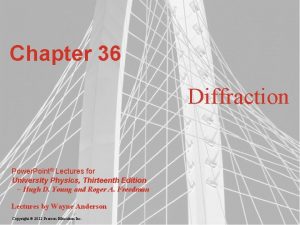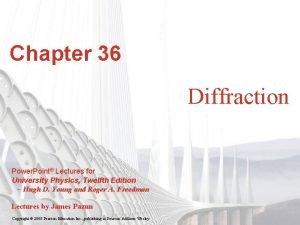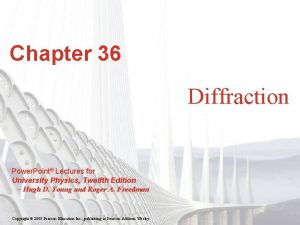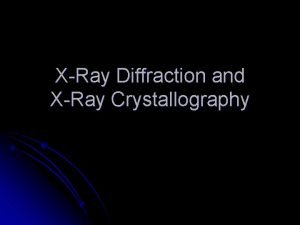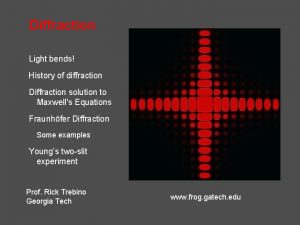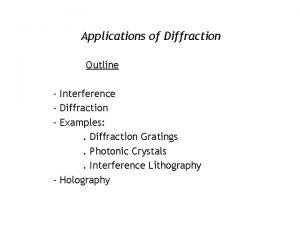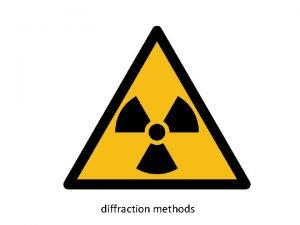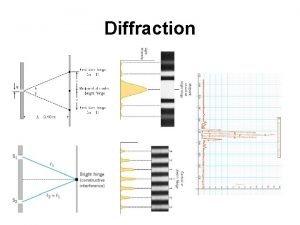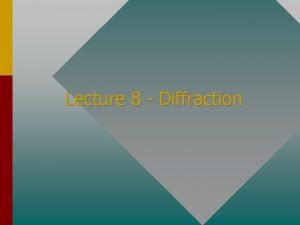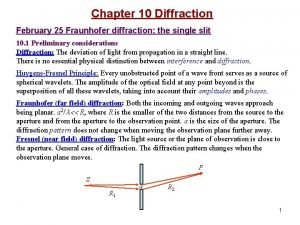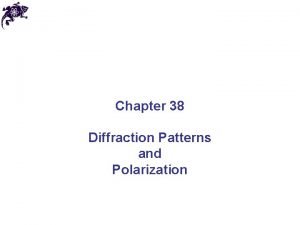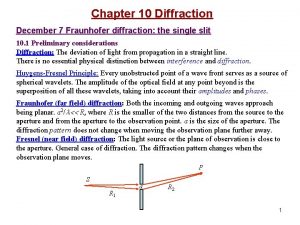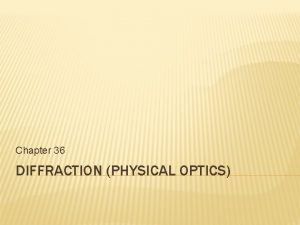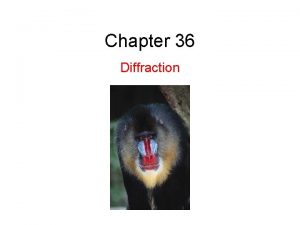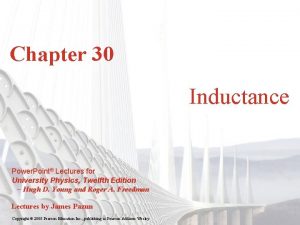Chapter 36 Diffraction Power Point Lectures for University

































- Slides: 33

Chapter 36 Diffraction Power. Point® Lectures for University Physics, 14 th Edition – Hugh D. Young and Roger A. Freedman © 2016 Pearson Education Inc. Lectures by Jason Harlow

Learning Goals for Chapter 36 Looking forward at … • how to calculate the intensity at various points in a single-slit diffraction pattern. • what happens when coherent light shines on an array of narrow, closely spaced slits. • how x-ray diffraction reveals the arrangement of atoms in a crystal. • how diffraction sets limits on the smallest details that can be seen with an optical system. • how holograms work. © 2016 Pearson Education Inc.

Introduction • Flies have compound eyes with thousands of miniature lenses, each only about 20 μm in diameter. • Due to the wave-nature of light, the ability of a lens to resolve fine details improves as the lens diameter D increases. • Each miniature lens in a fly’s eye has very poor resolution, compared to those produced by a human eye, because the lens is so small. • We’ll continue our exploration of the wave nature of light with diffraction. © 2016 Pearson Education Inc.

Diffraction • According to geometric optics, when an opaque object is placed between a point light source and a screen, the shadow of the object forms a perfectly sharp line. • However, the wave nature of light causes interference patterns, which blur the edge of the shadow. • This is one effect of diffraction. © 2016 Pearson Education Inc.

Diffraction and Huygen’s principle • This photograph was made by placing a razor blade halfway between a pinhole, illuminated by monochromatic light, and a photographic film. • The film recorded the shadow cast by the blade. • Note the fringe pattern around the blade outline, which is caused by diffraction. © 2016 Pearson Education Inc.

Diffraction from a single slit © 2016 Pearson Education Inc.

Diffraction from a single slit © 2016 Pearson Education Inc.

Fresnel diffraction by a single slit © 2016 Pearson Education Inc.

Fraunhofer diffraction by a single slit © 2016 Pearson Education Inc.

Locating the dark fringes • Shown is the Fraunhofer diffraction pattern from a single horizontal slit. • It is characterized by a central bright fringe centered at θ = 0, surrounded by a series of dark fringes. • The central bright fringe is twice as wide as the other bright fringes. © 2016 Pearson Education Inc.

Intensity in the single-slit pattern • We can derive an expression for the intensity distribution for the single-slit diffraction pattern by using phasoraddition. • We imagine a plane wave front at the slit subdivided into a large number of strips. • At the point O, the phasors are all in phase. © 2016 Pearson Education Inc.

Intensity in the single-slit pattern • Now consider wavelets arriving from different strips at point P. • Because of the differences in path length, there are now phase differences between wavelets coming from adjacent strips. • The vector sum of the phasors is now part of the perimeter of a many-sided polygon. © 2016 Pearson Education Inc.

Intensity maxima in a single-slit pattern • Shown is the intensity versus angle in a single-slit diffraction pattern. • Most of the wave power goes into the central intensity peak (between the m = 1 and m = − 1 intensity minima). © 2016 Pearson Education Inc.

Width of the single-slit pattern • The single-slit diffraction pattern depends on the ratio of the slit width a to the wavelength. • Below is the pattern when a = λ. © 2016 Pearson Education Inc.

Width of the single-slit pattern • The single-slit diffraction pattern depends on the ratio of the slit width a to the wavelength. • Below are the patterns when a = 5λ (left) and a = 8λ (right). © 2016 Pearson Education Inc.

Two slits of finite width • Figure (a) shows the intensity in a single-slit diffraction pattern with slit width a. • The diffraction minima are labeled by the integer md = ± 1, ± 2, … (“d” for “diffraction”). • Figure (b) shows the pattern formed by two very narrow slits with distance d between slits, where d is four times as great as the single-slit width a. • “i” is for “interference. ” © 2016 Pearson Education Inc.

Two slits of finite width • Figure (c) shows the pattern from two slits with width a, separated by a distance (between centers) d = 4 a. • The two-slit peaks are in the same positions as before, but their intensities are modulated by the single-slit pattern, which acts as an “envelope” for the intensity function. • Figure (d) shows the pattern, which is both from diffraction and interference. © 2016 Pearson Education Inc.

Several slits • Shown is an array of eight narrow slits, with distance d between adjacent slits. • Constructive interference occurs for rays at angle θ to the normal that arrive at point P with a path difference between adjacent slits equal to an integer number of wavelengths. © 2016 Pearson Education Inc.

Interference pattern of several slits • Shown is the result of a detailed calculation of the eight-slit pattern. • The large maxima, called principal maxima, are in the same positions as for a two-slit pattern, but are much narrower. © 2016 Pearson Education Inc.

Interference pattern of several slits • Shown is the result for 16 slits. • The height of each principal maximum is proportional to N 2, so from energy conservation, the width of each principal maximum must be proportional to 1/N. © 2016 Pearson Education Inc.

The diffraction grating • An array of a large number of parallel slits is called a diffraction grating. • In the figure, is a cross section of a transmission grating. • The slits are perpendicular to the plane of the page. • The diagram shows only six slits; an actual grating may contain several thousand. © 2016 Pearson Education Inc.

The reflection grating • The rainbow-colored reflections from the surface of a DVD are a reflection-grating effect. • The “grooves” are tiny pits 0. 12 mm deep in the surface of the disc, with a uniform radial spacing of 0. 74 mm = 740 nm. • Information is coded on the DVD by varying the length of the pits. • The reflection-grating aspect of the disc is merely an aesthetic side benefit. © 2016 Pearson Education Inc.

Diagram of a grating spectrograph © 2016 Pearson Education Inc.

Resolution of a grating spectrograph • In spectroscopy it is often important to distinguish slightly differing wavelengths. • The minimum wavelength difference Δλ that can be distinguished by a spectrograph is described by the chromatic resolving power R. • For a grating spectrograph with a total of N slits, used in the mth order, the chromatic resolving power is: © 2016 Pearson Education Inc.

X-ray diffraction • When x rays pass through a crystal, the crystal behaves like a diffraction grating, causing x-ray diffraction. © 2016 Pearson Education Inc.

A simple model of x-ray diffraction • To better understand x-ray diffraction, we consider a two-dimensional scattering situation. • The path length from source to observer is the same for all the scatterers in a single row if θa = θr = θ. © 2016 Pearson Education Inc.

Circular apertures • The diffraction pattern formed by a circular aperture consists of a central bright spot surrounded by a series of bright and dark rings. © 2016 Pearson Education Inc.

Diffraction by a circular aperture • The central bright spot in the diffraction pattern of a circular aperture is called the Airy disk. • We can describe the radius of the Airy disk by the angular radius θ 1 of the first dark ring: © 2016 Pearson Education Inc.

Diffraction and image formation • Diffraction limits the resolution of optical equipment, such as telescopes. • The larger the aperture, the better the resolution. • A widely used criterion for resolution of two point objects, is called Rayleigh’s criterion: - Two objects are just barely resolved (that is, distinguishable) if the center of one diffraction pattern coincides with the first minimum of the other. © 2016 Pearson Education Inc.

Bigger telescope, better resolution • Because of diffraction, large-diameter telescopes, such as the VLA radio telescope below, give sharper images than small ones. © 2016 Pearson Education Inc.

What is holography? • By using a beam splitter and mirrors, coherent laser light illuminates an object from different perspectives. • Interference effects provide the depth that makes a threedimensional image from two-dimensional views. © 2016 Pearson Education Inc.

Viewing the hologram • A hologram is the record on film of the interference pattern formed with light from the coherent source and light scattered from the object. • Images are formed when light is projected through the hologram. • The observer sees the virtual image formed behind the hologram. © 2016 Pearson Education Inc.

An example of holography • Shown below are photographs of a holographic image from two different angles, showing the changing perspective. © 2016 Pearson Education Inc.
 Power system lectures
Power system lectures Dispersive power of grating equation
Dispersive power of grating equation Power triangle
Power triangle Power bi power point
Power bi power point Point point power
Point point power Rick trebino
Rick trebino Neonatology lectures
Neonatology lectures Data mining lectures
Data mining lectures Medicinal chemistry lectures
Medicinal chemistry lectures Uva presentation template
Uva presentation template Cs614 short lectures
Cs614 short lectures Activity planning in software project management
Activity planning in software project management Molecular biology lecture
Molecular biology lecture Radio astronomy lectures
Radio astronomy lectures Dr sohail lectures
Dr sohail lectures Utilities and energy lectures
Utilities and energy lectures Web engineering lectures ppt
Web engineering lectures ppt How to get the most out of lectures
How to get the most out of lectures Frcr physics lectures
Frcr physics lectures Frcr physics lectures
Frcr physics lectures Introduction to recursion
Introduction to recursion Guyton physiology lectures
Guyton physiology lectures Aerodynamics lecture
Aerodynamics lecture Theory of translation lectures
Theory of translation lectures What is text linguistics
What is text linguistics Theory of translation lectures
Theory of translation lectures Digital logic design lectures
Digital logic design lectures Kurose ross computer networking
Kurose ross computer networking What is hegelian philosophy
What is hegelian philosophy Nuclear medicine lectures
Nuclear medicine lectures Gpoint c++
Gpoint c++ Cdeep lectures
Cdeep lectures Oral communication 3 lectures text
Oral communication 3 lectures text C programming and numerical analysis an introduction
C programming and numerical analysis an introduction


































